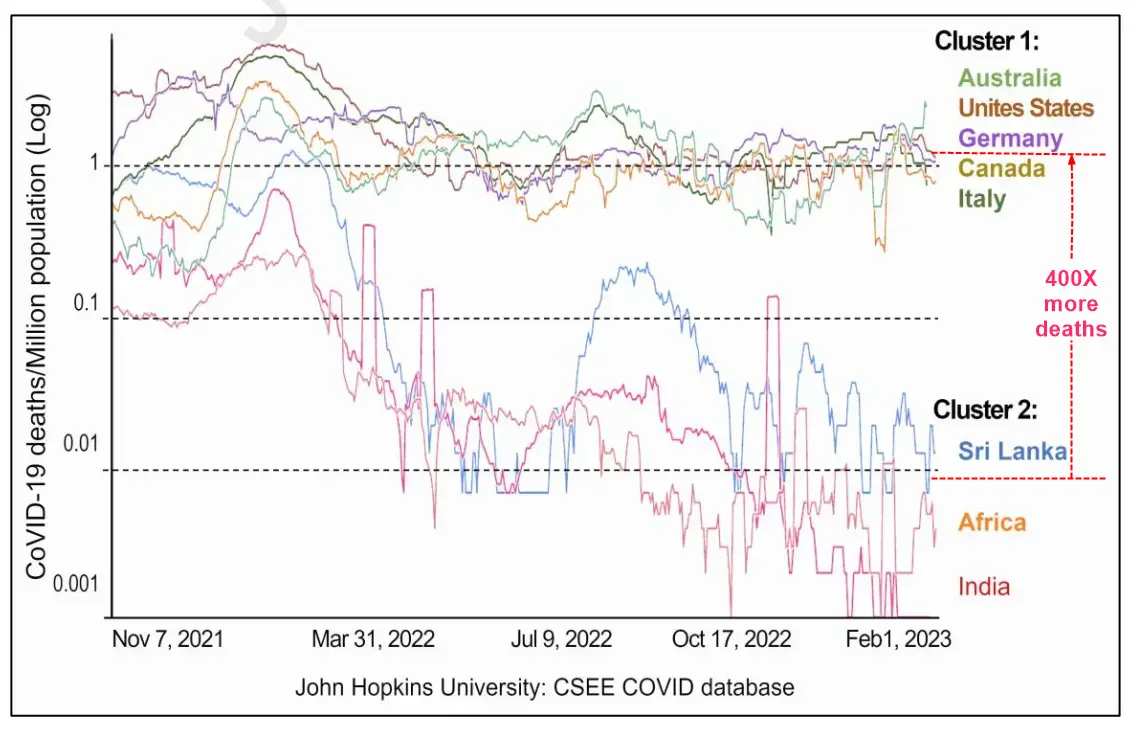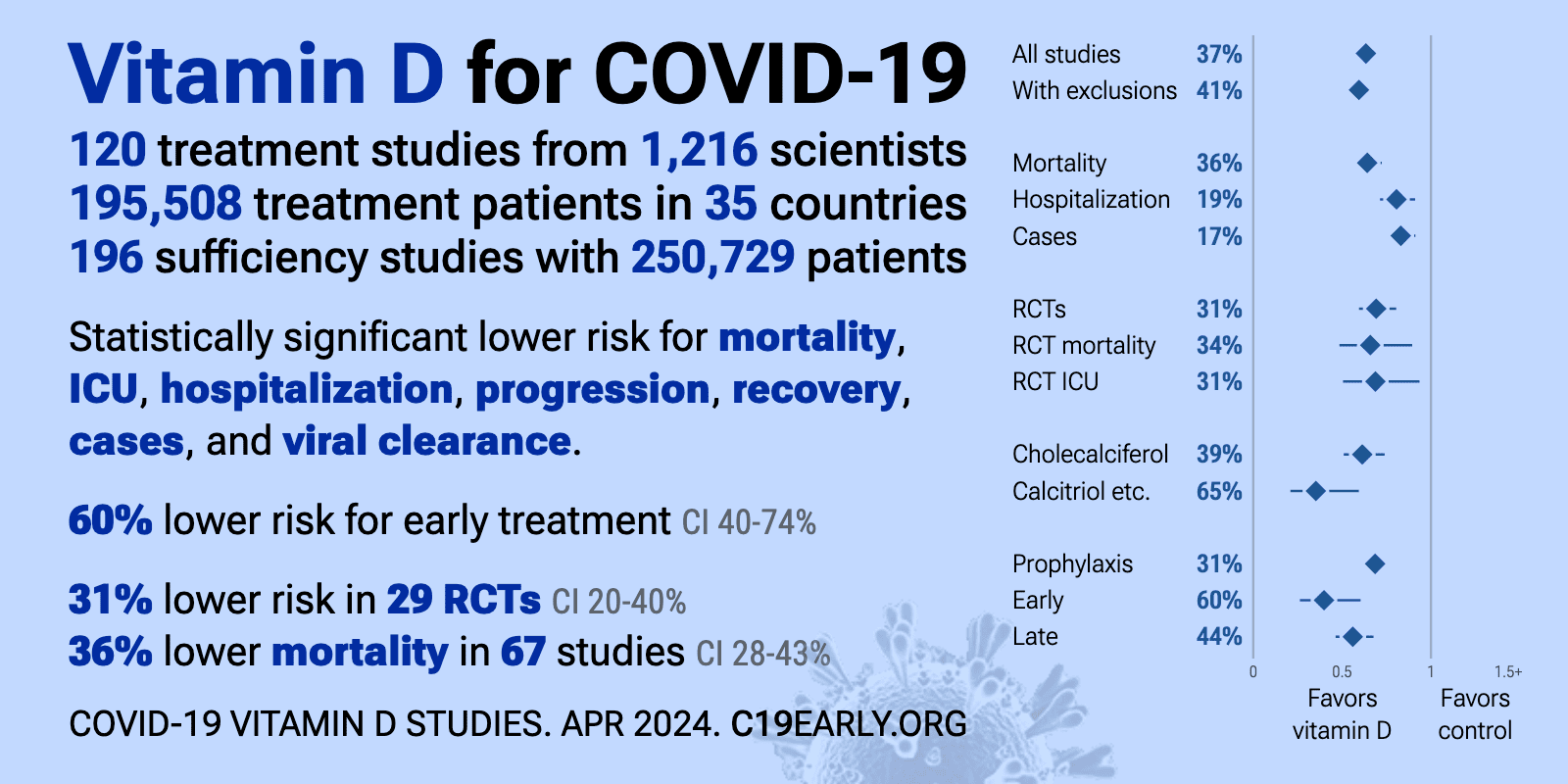400X fewer COVID deaths in countries with fewer vaccinations
Unlocking Insights: Navigating COVID-19 Challenges and Emulating Future Pandemic Resilience Strategies with Strengthening Natural Immunity
Heliyon https://doi.org/10.1016/j.heliyon.2024.e34691
Sunil J. Wimalawansa

Figure 6: The data on deaths from COVID-19, spanning from November 2021 to February 2023, presented as the rolling seven-day average deaths per million population, clearly illustrates a stark 400-fold difference in death rates between the two clusters.
Cluster 1 comprises industrialized countries with over 70% of the population fully vaccinated, while
Cluster 2 represents African countries with less than 15% vaccination coverage.
Notably, India and Sri Lanka achieved higher vaccination percentages in late 2022, and their death rates were already low before the initiation of vaccination campaigns. The data is expressed as deaths per million population and adapted from Our World COVID data based on the Johns Hopkins University database. https://coronavirus.jhu.edu/
Highlights:
COVID-19 outbreaks coincided with each winter when population vitamin D levels are lowest.
In 2021, the COVID-19 vaccine reduced SARS-CoV-2 hospitalizations; however, with emerging mutants and immune evasion,‰% the rate of infection and hospitalization increased from late 2021.
The efficacy of SARS-CoV-2 mRNA and bivalent vaccines against Omicron significantly reduced from late 2022 ‰%due to new mutants and immune evasion causing outbreaks.
Vitamin D is a potent anti-inflammatory and anti-oxidant, which helps negate the adverse effects of viruses and vaccines.
Exploring alternative cost-effective therapies, like vitamin D and ivermectin, is essential to prepare for future pandemics.
Abstract The original COVID-19 vaccines, developed against SARS-CoV-2, initially mitigated hospitalizations. Bivalent vaccine boosters were used widely during 2022-23, but the outbreaks persisted. Despite this, hospitalizations, mortality, and outbreaks involving dominant mutants like Alpha and Delta increased during winters when the population's vitamin D levels were at their lowest.
Notably, 75% of human immune cell/system functions, including post-vaccination adaptive immunity, rely on adequate circulatory vitamin D levels . Consequently, hypovitaminosis compromises innate and adaptive immune responses, heightening susceptibility to infections and complications. COVID-19 vaccines primarily target SARS-CoV-2 Spike proteins, thus offering limited protection through antibodies. mRNA vaccines, such as those for COVID-19, fail to generate secretory/mucosal immunity-like IgG responses, rendering them ineffective in halting viral spread. Additionally, mutations in the SARS-CoV-2 binding domain reduce immune recognition by vaccine-derived antibodies, leading to immune evasion by mutant viruses like Omicron variants. Meanwhile, the repeated administration of bivalent boosters intended to enhance efficacy resulted in the immunoparesis of recipients. As a result, relying solely on vaccines for outbreak prevention became less effective. Dominant variants exhibit increased affinity to angiotensin-converting enzyme receptor-2, enhancing infectivity but reducing virulence. Meanwhile, spike protein-related viral mutations do not impact the potency of widely available, repurposed early therapies, like vitamin D and ivermectin. With the re-emergence of COVID-19 and impending coronaviral pandemics, regulators and health organizations should proactively consider approval and strategic use of cost-effective adjunct therapies mentioned above to counter the loss of vaccine efficacy against emerging variants and novel coronaviruses and eliminate serious adverse effects. Timely implementation of these strategies could reduce morbidity, mortality, and healthcare costs and provide a rational approach to address future epidemics and pandemics. This perspective critically reviews relevant literature, providing insights, justifications, and viewpoints into how the scientific community and health authorities can leverage this knowledge cost-effectively.
📄 Download the PDF from VitaminDWiki
10 related studies in VitaminDWiki
Multiple COVID vaccinations might increase (turbo) Cancer Incidence - many studies
Vaccines increased your risk of dying of COVID in NZ - official data - Feb 2024
COVID infections and vaccinations decrease Vitamin D – many studies
COVID vaccination problems 1000 X worse than Thalidomide - Dec 2023
Hospital utilization Australia (NSW) 1415 Vaccinated, 0 unvaccinated - Dec 2022
Excess deaths in 34 countries (probably due to COVID vaccination) – preprint Aug 2023
Prevent a COVID death: 9 dollars of Vitamin D or 900,000 dollars of vaccine - Aug 2023
Problems with vaccine use during a pandemic - Dr. Bossche 2021 - 2023
More COVID vaccinations, more infections - Cleveland Clinic - Dec 2022
VitaminDWiki – COVID-19 treated by Vitamin D - studies, reports, videos
{include}

- The above image is automatically updated
